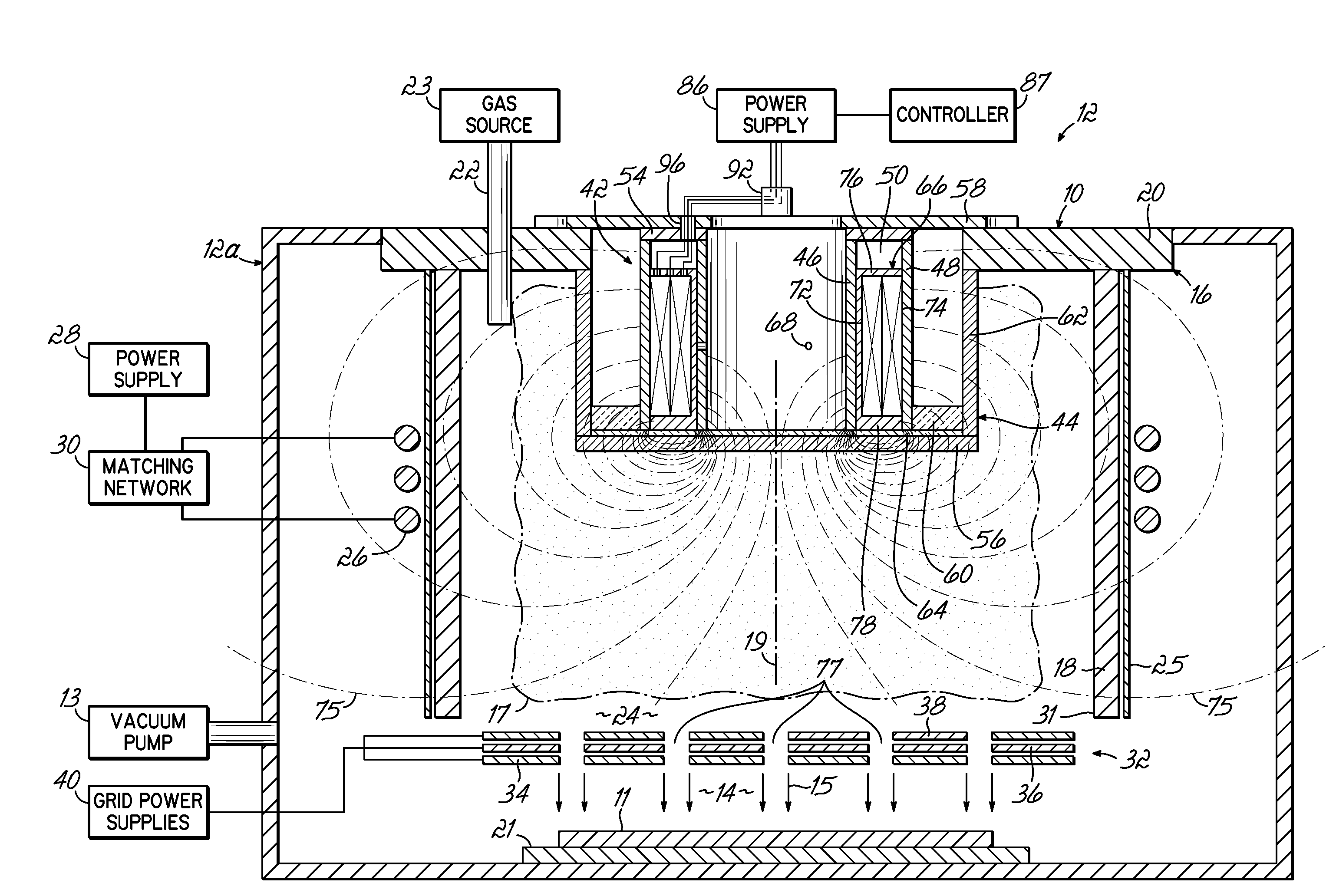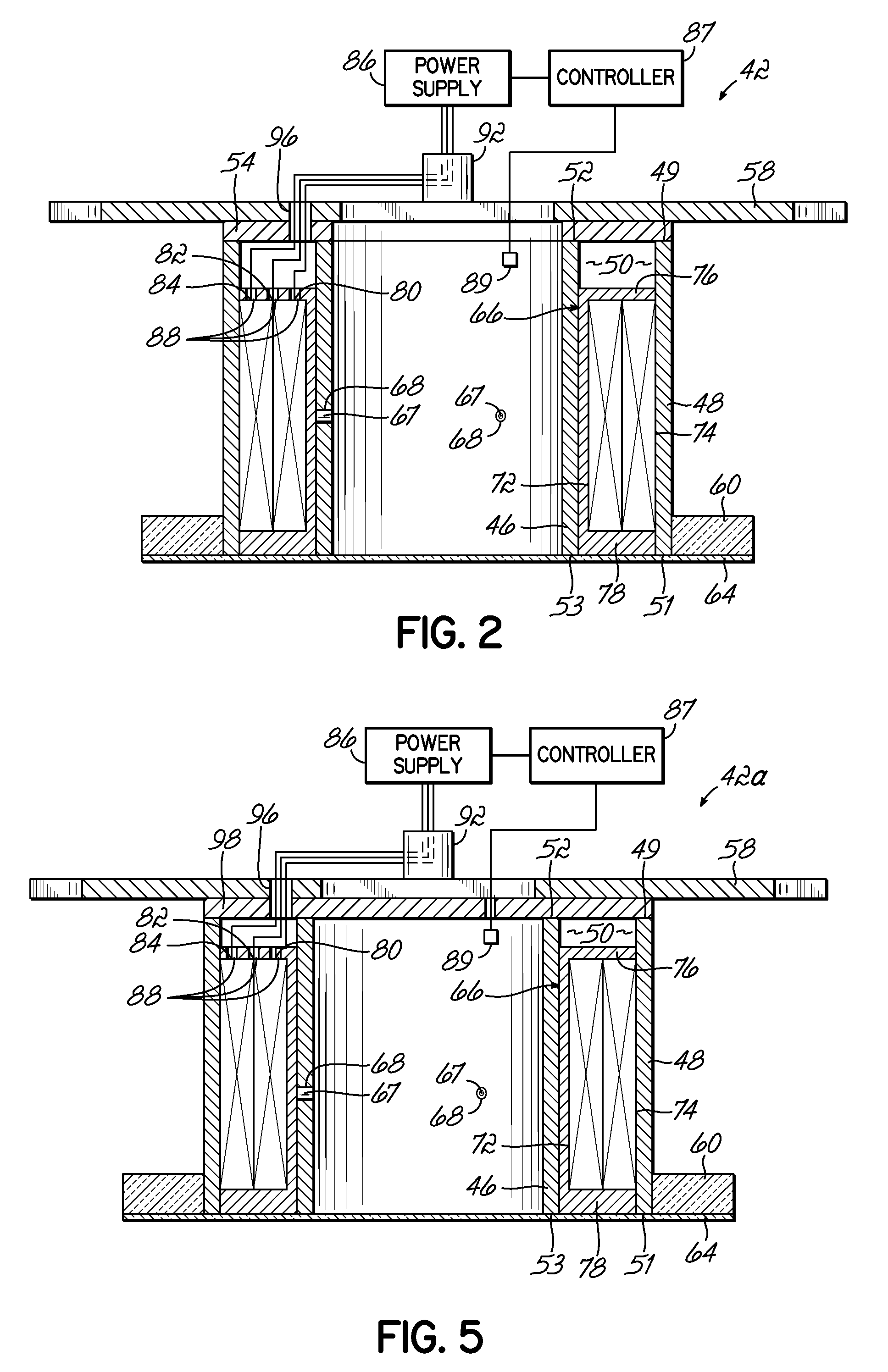Methods of operating an electromagnet of an ion source
an ion source and electromagnet technology, applied in the direction of fluid pressure measurement, instruments, ion beam tubes, etc., can solve the problems of inability to transparently observe the ion optics, the compensation method has several limitations, and the distribution of ion current density is not uniform
- Summary
- Abstract
- Description
- Claims
- Application Information
AI Technical Summary
Benefits of technology
Problems solved by technology
Method used
Image
Examples
example 1
[0085]An ion source having an electromagnet assembly, otherwise substantially identical to electromagnet 42b (FIG. 6) but with each of the inner and outer coils including a single coil of 970 turns, was equipped with an ammeter between the coil of the radially innermost electromagnet and power supply for purposes of measuring the current supplied to the radially outermost coil of this electromagnet 42b. The coil of the radially outermost electromagnet was disconnected from the power supply so that only the innermost coil of the electromagnet 42b was energized. An electrical probe was inserted into the beam and situated in the substrate plane perpendicular to the beam incidence direction. A voltage was measured from the electrical probe, which was charged under the substrate processing conditions. This voltage was considered as a measure of the broad ion beam neutralization. A 1200 V, 650 mA beam of positively charged ions was extracted from an argon gas plasma. While propagating tow...
example 2
[0089]As evidence that the operation of the electromagnet under controlled conditions does not degrade the ion beam directionality, the “local divergence angle” of the angular distribution of the ions was evaluated for optimum electromagnet current settings at different positions in the beam and compared with equivalent results obtained without the electromagnet for the same process parameters. The “local divergence angle” was determined by etching a substrate beneath a masking aperture and measuring the size of the etch spot, essentially as described by J. R. Kahn, et al, J. Vac. Sci. Technol. A14(4), July / August 1996, p. 2106-2112 (ref. FIG. 1), except that a silicon dioxide coated silicon wafer was used as the substrate and a nanospectrophometric measurement apparatus (Nanometrics Nanospec™ 8000) capable of high resolution etch depth and lateral position measurement was used to determine the etch depth profile. The disclosure of this publication is hereby incorporated by referenc...
example 3
[0091]A series of ion etch profiles, which have been normalized for presentation, were generated using the ion source and operating parameters (except for the current applied to the electromagnet) of Example 1 and are shown in FIG. 9. With no current applied to the coils of the electromagnet (and therefore no field strength), the plasma density distribution and the distribution of plasma ion flux are characterized by a convex profile, which is reflected in the ion etch profile of curve 200. At a relatively low field strength, BL, the plasma density distribution and the distribution of plasma ion flux increase in convexity with increasing field strengthen, as reflected in the ion etch profile of curve 210. At a relatively high field strength, BH, the plasma density distribution and the distribution of plasma ion flux changes shape to become more concave with increasing field strength. Eventually, the plasma density distribution and the distribution of plasma ion flux change to a conc...
PUM
| Property | Measurement | Unit |
|---|---|---|
| pressures | aaaaa | aaaaa |
| vacuum pressure | aaaaa | aaaaa |
| frequency | aaaaa | aaaaa |
Abstract
Description
Claims
Application Information
 Login to View More
Login to View More - R&D
- Intellectual Property
- Life Sciences
- Materials
- Tech Scout
- Unparalleled Data Quality
- Higher Quality Content
- 60% Fewer Hallucinations
Browse by: Latest US Patents, China's latest patents, Technical Efficacy Thesaurus, Application Domain, Technology Topic, Popular Technical Reports.
© 2025 PatSnap. All rights reserved.Legal|Privacy policy|Modern Slavery Act Transparency Statement|Sitemap|About US| Contact US: help@patsnap.com



